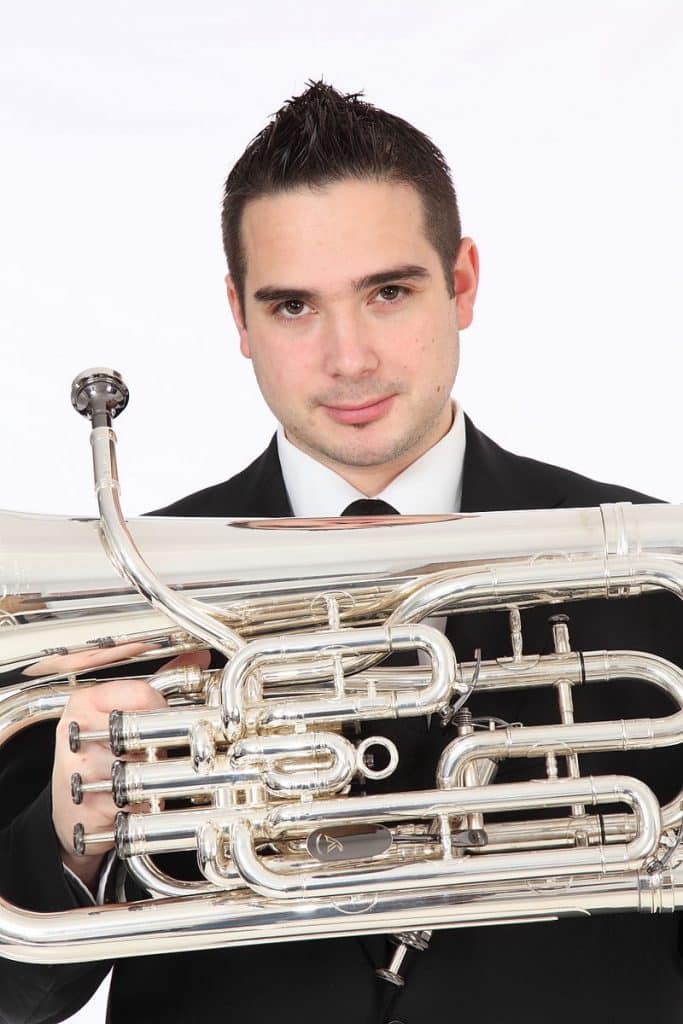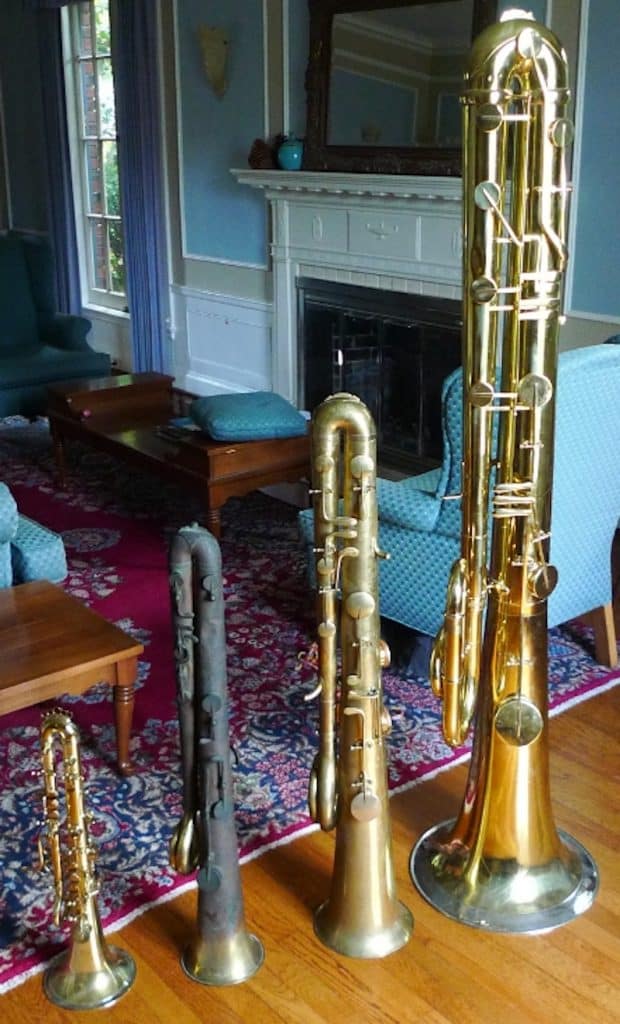While you might confuse it for a tuba, a euphonium is another horn instrument that plays a higher range of notes than its closely related musical cousin. In recent years, it’s gained popularity as a fantastic high-school band instrument and slightly smaller alternative to the tuba.
In this article, we’ll go over some fun and interesting facts about the euphonium. Keep reading if you’re looking to learn how to play the euphonium or if you’re just interested in learning more about this cool instrument.
1. The Euphonium Is NOT a Tuba

While we’ve already said it in the intro, it deserves saying again. The euphonium is NOT the same instrument as the tuba.
While the two instruments look incredibly similar, the euphonium is slightly smaller and produces higher notes than the tuba.
As such, they serve very different positions in any orchestral band.
2. Euphoniums Aren’t Always Present in Orchestras
Euphoniums have been having a bit of an identity crisis over the years.
While many composers value them for their high notes in the brass section, experienced tuba players can also hit those notes without much of an issue.
Plus, the tuba can go much lower, giving it more range to play around with. As a result, euphoniums aren’t always in an orchestral lineup.
But, concert bands will often feature euphoniums over tubas or other brass instruments.
This is because they round out the melody produced by other instruments very nicely, producing a fantastic sound that projects well in concert halls.
3. The Euphonium Gets its Name From the Ancient Greeks
The Euphonium gets its name from the Ancient Greek word euphōnos, meaning ‘sweet-voiced or ‘well-sounding’.
This is not surprising that the first people to construct the instrument named it that, as the euphonium’s sound is reminiscent of the sirens of old Greek myth.
However, while the name might be Ancient Greek, they’re definitely not the ones to invent the euphonium.
5. It’s Unclear Who Invented the Euphonium
Three people are generally credited with inventing the euphonium, but it’s unclear who was the actual creator.
Carl Moritz may have been the first to develop a prototype euphonium in 1838, but it may have also been Ferdinand Sommer in 1843 or Adolphe Sax the same year.
Adolphe Sax (the inventor of the saxophone), in particular, is interesting because his family’s saxhorns, especially the bass saxhorn, were very similar to future euphoniums.
It could be that people used his instruments as a blueprint for modern euphoniums, but it’s hard to be sure without more evidence.
6. The Euphonium is Very Similar to the Baritone Horn
Feeding the euphonium’s continuing identity crisis, many music historians argue it’s the same instrument as the baritone horn.
While euphonium proponents would argue otherwise, the fact remains that the two instruments are extremely similar in size, shape, and sound.
However, the euphonium is almost always a bit larger than a baritone horn.
Also, baritone horns typically feature a cylindrical bore, while euphoniums have conical bores.
As such, they’re considered to be two separate instruments, albeit belonging to the same brass horn family.
7. The Euphonium Descends From Some Old Instruments
The Ophicleide preceded the euphonium by about twenty years, invented by a Frenchman named Jean Hilaire Aste.
Its design heavily influenced the euphonium and tuba and is considered the originator of this family of instruments.
However, before the ophicleide, there was the Serpent, a renaissance period instrument that was a twisting horn-like instrument that resembled a snake.
And even before the serpent people played the cornett, a simple horn with finger holes dating all the way back to the 15th century.
In fact, the first horned instrument was the shofar, invented over 3000 years ago!
8. Modern Euphoniums Were Developed in 1874
David Blaikley invented the “British-style” euphonium in 1874 while working for Boosey & Co.
Manufacturers have tried to make minor adjustments to the euphonium’s construction to make it more efficient but haven’t made any major changes since Blaikley’s instrument.
Today, almost all concert bands and orchestras use the compensating euphonium.
9. Today’s Euphonium Players are Making a Name for Themselves

While the Euphonium doesn’t get that much attention, there are a number of famous euphonium players like David Childs, Demondrae Thurman, and Steven Mead who have garnered reputations as being some of the most talented musicians around.
David Childs, in particular, has won many awards for his artistry, and musicians like him are spreading the good word about the euphonium to concert halls all around the world.
10. Euphoniums are Often Considered a ‘Jack of all Trades’
Even the best orchestras suffer mishaps occasionally.
When your only tuba breaks and you need a horn to hit those low octaves, conductors often call for euphonium players to fill the gap.
Since euphoniums can hit a range of notes that other horns can’t, they’re often used as replacements when primary horn players can’t attend a performance.
Also, euphoniums commonly replace other horns for pieces that require a wider sound spectrum from the brass section.
11. There Are Four Types of Euphoniums
Although the British compensating euphonium is the most commonly used in orchestras worldwide, there are three other types of euphoniums that many players prefer instead.
These include the double-bell euphonium, marching euphonium, and five-valves euphonium.
Compensating euphoniums use a three-plus-one valve system to achieve correct intonations in the lower spectrum.
Marching euphoniums are typically in, well, marching bands.
Double-bell models let players switch to a smaller bell by using an additional valve.
Finally, the five-valves euphonium is a larger version with two extra valves that’s extremely rare.
12. The Euphonium Leads in the Military
Military bands are often considered some of the best in the country.
Their discipline, dedication, and skill at the craft allow them to make tough pieces look easy.
Then, it’s equally extraordinary that the euphonium is the leading brass instrument in tenor-bass military bands.
The euphonium got its real start in American and British bands playing in military bands, which were the first groups to spread the siren call of the instrument to the masses.
13. Euphonium Players Can’t Agree on a Name
The names for euphonium players are just as varied as the instrument they play.
Often, euphonium players can’t agree amongst themselves what their official title should be.
In general, there are three terms used for euphonium players: euphoniumist, euphophonist, or euphonist.
Whatever name you prefer, be prepared for people to mispronounce it.
14. The Instrument and the Music Don’t Match Up
While the euphonium is in the key of B flat, most sheet music written for the instrument is in the key of C.
When the euphonium first started gaining popularity, there weren’t any specialized euphonium or tuba players that could easily read sheet music in B♭.
As a result, most composers just wrote the music in C to make it easier for other players.
15. Famous Euphonium Pieces
While the euphonium is in many famous classical orchestral and concert pieces, there aren’t as many compositions devoted to making the instrument the main focus.
However, there are still some, and the ones that do exist are well-known as exceptional works.
The first piece to focus on the Euphonium was Concerto no. 3, written by Alan Hovhaness in 1948.
After the 1960s, though, more and more solo pieces were composed for the euphonium.
This era’s first serious euphonium works were Americans Warner Hutchinson’s Sonatina in 1966 and Donald White’s Lyric Suite in 1970.
Wrapping Up our List of Euphonium Facts
And that wraps up our list of interesting facts about the euphonium!
We hope you’ve learned some cool new things about this amazing instrument.
Now, the next time you hear someone call the euphonium a tuba or a baritone horn, you can call them out!
The euphonium deserves some recognition too, and hopefully, this list has inspired you to learn how to play the euphonium or even just listen to some compositions!


